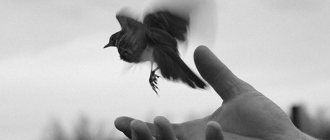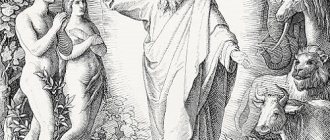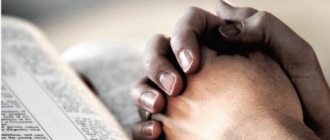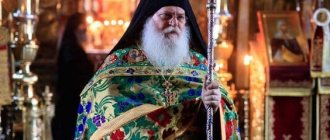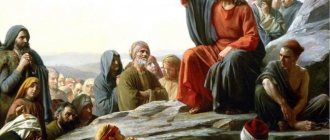The language of the New Testament.
The texts of the New Testament were written in the common language of the eastern Mediterranean - KOINE Greek. Later, the texts of the New Testament were translated from Greek into Latin, Syriac and Aramaic. In the II-III centuries. It was believed among early textual scholars that the Gospel of Matthew was written in Aramaic and the Epistle to the Hebrews in Hebrew, but this view has not been confirmed. There is a small group of modern scholars who believe that the texts of the New Testament were originally written in Aramaic and then translated into Koine, but many textual studies say otherwise.
Old Testament
A covenant is a union, in this case, the union of a person with God. The Old Testament describes prophecies about the coming of the Messiah, as well as God's instructions to people, transmitted through preachers.
The book begins with a description of the creation of the world and the Fall, then there is a story about the life of the children of Adam and Eve, the sin of Cain’s fratricide of Abel and the further life of subsequent generations. After the first fall, when the serpent tempted Eve to taste the forbidden fruit, and then Adam was tempted, humanity also learned other vicious acts and continues to live in sin.
In the well-known story of the Old Testament, the Lord appeared to the prophet Moses on Mount Sinai and ordered him to keep the 10 commandments (written on stone tablets) and carry them to the people. With the help of these instructions, God gives the Jews a guide to a righteous life. However, there are still those who are unwilling to humble their whims, trust God and build a bright Orthodox future. People do not understand that all troubles do not come from external forces, but are the result of their own actions and thoughts.
In general, the Old Testament is aimed at Jews and is written mostly in their language, some in Aramaic. Later Old Testament materials contain Assyrian and Babylonian words, and 3 Ezra was written in Latin.
The period from the prophet Moses (1550 BC) to Samuel (1050 BC) should be considered the first period of the creation of the Holy Books.
The written revelations and laws were put into the Ark of the Covenant (a special chest that God himself commanded to be used to store the commandments).
The Old Testament part of the Bible consists of several types of books:
- The Pentateuch of Moses, otherwise the Torah (Genesis, Exodus, Leviticus, Numbers, Deuteronomy);
- historical books;
- teaching;
- prophetic writings;
- non-canonical books.
Before printing began, stories were written on papyrus or parchment with a reed dipped in ink. Books were then called charters and were presented in the form of scrolls wound on a shaft.
Later, the sheets began to be divided into sheets and sewn together, which was more like modern books. However, back then there were no uppercase or lowercase letters, spaces between words, or punctuation marks, so it was difficult to read continuous text made up of capital letters.
By the way, the Hebrew language had no vowels at all.
Canonization of the Books of the New Testament
The canonization of the New Testament lasted almost three centuries. The Church became concerned with the canonization of the New Testament in the middle of the 2nd century. There was a specific reason for this - it was necessary to resist the widespread Gnostic teachings. Moreover, there was no talk of canonization in the 1st century due to the constant persecution of Christian communities. Theological reflection begins around 150.
Let's define the main milestones of the canonization of the New Testament.
Canon Muratori
According to the Muratori canon dating back to the year 200, the New Testament did not include:
- Paul's Epistle to the Hebrews
- Both Epistles of Peter
- Third Epistle of John
- Epistle of James.
But the Apocalypse of Peter, which is now considered an apocrypha, was considered the canonical text.
By the end of the 3rd century, the Canon of the Gospels was adopted.
The books of the New Testament were canonized by the Christian Church at the Ecumenical Councils. Only two books from the New Testament were accepted into the canon, with some problems:
- Revelation of John the Theologian (due to the mystical nature of the narrative);
- One of the Epistles of the Apostle Paul (due to doubts about authorship)
The Church Council of 364 approved the New Testament in the amount of 26 books. The Apocalypse of John the Evangelist was not included in the canon.
The canon took shape in its final form in 367. Athanasius the Great in his 39th Easter Epistle lists 27 books of the New Testament.
It should certainly be mentioned that, in addition to certain theological characteristics of the texts included in the canon, the canonization of the New Testament was influenced by a geographical factor. Thus, the New Testament included writings that were kept in the churches of Greece and Asia Minor.
A large number of works of Christian literature of the 1st-2nd centuries. were considered apocryphal.
Biography - New Testament, philosophy New Books New Works New
Biography
The New Testament (ancient Greek: Καινὴ Διαθήκη) is a collection of books, which is one of two, along with the Old Testament, parts of the Bible. Story. The original texts of the New Testament, which appeared at various times from the middle to the end of the 1st century AD. BC, were written in Koine Greek, which was considered at that time the common language of the eastern Mediterranean. Gradually formed during the first centuries of Christianity, the canon of the New Testament now consists of 27 books - the four Gospels describing the life and preaching of Jesus Christ, the book of the Acts of the Apostles, which is a continuation of the Gospel of Luke, twenty-one epistles of the apostles, as well as the book of Revelation of John the Theologian (apocalypse ). The concept of “New Testament” (lat. Novum Testamentum) in its current understanding is found in the Apostle Paul in the first and second letters to the Corinthians (1 Cor. 11:25, 2 Cor. 3:6). Also, this same concept was used in the Synoptic Gospels by Christ himself (Matthew 26:28, Mark 14:24, Luke 22:20). The concept of “New Testament” was introduced into Christian theology at the end of the 2nd century - at the beginning of the 3rd century in the works of Clement of Alexandria, Tertullian and Origen. Although the very concept of the New Covenant (Hebrew: בְּרִית חֲדָשָׁה) was first used in the book of the prophet Jeremiah: “Behold, the days are coming, says the Lord, when I will make a new covenant with the house of Israel and with the house of Judah” (Jer. 31:31). In pre-Christian times, members of the Jewish Qumran community used the same concept of the New Testament, or New Union (in the sense of union with God). The earliest of the texts of the New Testament are considered to be the epistles of the Apostle Paul, and the latest are the works of John the Theologian. Irenaeus of Lyons believed that the Gospel of Matthew and the Gospel of Mark were written at the time when the apostles Peter and Paul were preaching in Rome (60s AD), and the Gospel of Luke a little later. In addition, according to Jerome: “Matthew... was the first in Judea to compile the Gospel of Christ in Hebrew letters and words for those who believed from circumcision; who then translated it into Greek is not well known” (De vuris inlustribus III).
Canonization of the New Testament. The books of the New Testament were canonized by the Christian Church at the Ecumenical Councils. Problems arose only with two books. In the East, the Revelation of John the Theologian was considered too mystical a book (it is still not read during services), and in the West they doubted the authorship of one of the Epistles of Paul. The so-called Muratori canon is known, named after the Milanese librarian who discovered in the 18th century an ancient papyrus fragment listing the canonical books of the New Testament. The fragment dates back to approximately 200, and lacks a number of works that later became part of the canon: Paul’s Epistle to the Hebrews, both Epistles of Peter, the Third Epistle of John, and the Epistle of James. But this canon includes the Apocalypse of Peter, which was later classified as apocrypha. The question of including the Apocalypse of John in the canon has long been controversial. The Laodicean local church council (364) approved the New Testament canon consisting of 26 books, which still constitute it today, without the Apocalypse. After this, the issue of the New Testament canon was discussed at two more local councils, the Council of Hippo (393) and Carthage (397), and was finally adopted by the second rule of the Fifth-Sixth Council (Trullo) (692). A large number of works of early Christian literature have been considered apocryphal. The Ethiopian Church has adopted a non-standard canon of the New Testament (it includes several books considered apocryphal by other Christians). Gospel texts are anonymous. Each of the Gospels was attributed to a specific author in the early second century.
The problem of language. Original Christianity spoke the language of the society from which it emerged. At the time of Jesus Christ, the most common languages in the Holy Land were Greek (Koine), Aramaic, and to a limited extent Mishnaic Hebrew, which was used primarily as a language of worship. Most scholars believe that the original texts of the New Testament were written in the Koine Greek dialect, which was the lingua franca of the Roman Empire's Eastern Mediterranean provinces in the 1st century AD. e. Later the texts were probably translated from Greek into other languages (Latin, Syriac, Coptic). It has been suggested, including by some of the Church Fathers of the 2nd and 3rd centuries, that the Gospel of Matthew was originally created in Hebrew or Aramaic, and the Epistle to the Hebrews was originally written in Hebrew and then translated by the Evangelist Luke into Greek. However, such assumptions have not found serious support among modern experts, who, based on the literary aspects of the texts of Matthew and the Epistle to the Hebrews, come to the conclusion that these works were also directly created in Koine. A significant minority of scholars consider the Aramaic version of the New Testament to be original, and consider the Greek texts to be translations. In particular, some Syriac scholars believe that the New Testament was originally written in the Galilean dialect of Aramaic (which is closely related to Syriac).
Textology. The number of known manuscripts of the New Testament greatly exceeds the number of manuscripts of any other ancient document (24 thousand manuscripts for the New Testament and 643 manuscripts for Homer's Iliad, the next largest list of texts known). Moreover, the time interval between the writing of the original and the date of the earliest extant manuscript of the New Testament is significantly less than this indicator for copies of the works of classical authors (20-30 years for the New Testament versus 1400 years for the most ancient reliable list of plays by Sophocles, which are considered extant essentially in its exact form).
Manuscripts of the New Testament.
Interesting fact: the number of manuscripts of the New Testament is many times greater than that of any other ancient text. Compare: about 24 thousand handwritten texts of the New Testament are known and only 643 manuscripts of Homer’s Iliad, which ranks second in the number of manuscripts. It is also interesting that the time difference between the actual creation of the text and the date of the extant manuscript is very small (20 - 40 years) when we are talking about the New Testament. The earliest manuscripts of the New Testament date back to the year 66 - this is a fragment of the Gospel of Matthew. The oldest complete list of New Testament texts dates back to the 4th century.
Manuscripts of the New Testament are usually classified into 4 types:
Alexandrian type. It is considered the closest to the original. (Vatican Codex, Codex Sinaiticus, Bodmer Papyrus)
Western type. Voluminous texts, which are largely retellings of the Biblical texts of the New Testament. (Beza Code, Washington Code, Claremont Code)
Caesarea type. Something in common between the Alexandrian and Western types (Code Corideti)
Byzantine type. Characterized “ improved” style, the grammatical forms here are close to the classical language. This is already the result of the work of an editor or group of editors of the 4th century. Most of the New Testament manuscripts that have come down to us belong to this type. (Alexandrian Codex, Textus Receptus)
Holy Scripture (Bible)
- The Holy Scriptures are a collection of sacred Books that present the content of God’s Revelation about Himself and about the world He created, about Divine Providence; the history of the implementation of God's plan for man is outlined, the requirements of the Divine will in relation to man are presented, the path along which man must follow in order to inherit eternal blissful life is indicated.
- The sacred inspired Books, in their totality, constitute the sacred canon. Adjacent to these Books are the so-called non-canonical books. They are not articulated by the Church as inspired by God, but are recognized as edifying and useful. All these Books together are called the Bible (from Greek: books).
- The Bible includes 77 books: 50 of them are contained in the Old Testament and 27 in the New. Of these, there are eleven non-canonical books (Tobit, Judith, Wisdom of Solomon, Wisdom of Jesus son of Sirach, Epistle of Jeremiah, Baruch, 2 and 3 books of Ezra, 1, 2 and 3 Maccabees).
- Holy Scripture is part of the Holy Tradition of the Church (understood in the broad sense of the expression): the early Church lived without a written Gospel according to oral Tradition.
- The books of Holy Scripture were written at different times over a period of about 1.5 thousand years - before the Nativity of Christ and after His Birth: the first are called the books of the Old Testament, the second - the books of the New Testament.
- The Holy Scriptures of the Old Testament were aimed at preparing man for the Coming of the Savior. The Holy Scripture of the New Testament reports about the Coming of the Savior, about His Atonement, the creation of the Church and the first stages of its history, that it is in the Church that human salvation is achievable; here the path of salvation is indicated and explained, the possible prospects for those sinners who do not want (do not want, did not want) to be saved are indicated.
- The Holy Scriptures are the result of the joint work of God and people. By participating in the compilation of the Books of Scripture, the latter did not act as a passive instrument in “the hands of God. God enlightened them with the light of His grace, revealed certain truths to them, and they presented them in proper literary form.
- The Holy Scripture is the book of the Church, the criterion for understanding it is the general church opinion, by consulting which you can avoid mistakes, because the Church is the pillar and foundation of the truth (1 Tim. 3:15).
***
The Bible is not a textbook on cosmogony, or natural science, or even history. This book is not scientific, but religious. And therefore, the main thing in it is not natural scientific facts or historical information, but what God was pleased to reveal about Himself to people.
The authors of the Bible are both God and men. God communicated about Himself what was necessary for human salvation. The historical authors of the Bible, perceiving the Word of God, clothed it in a certain literary form characteristic of the cultural and historical context of their time. To read the Bible correctly means to be able to distinguish between the Divine and the human in it. Therefore, reading the Bible is not only a rational, but also a deeply spiritual activity. Metropolitan Kirill of Smolensk and Kaliningrad
The New Testament is hidden in the Old, the Old is revealed in the New. St. Augustine, † 430
So, no one separates the Old Testament from the New, no one says that there is another spirit there and another here, for there is one God, the Lord of the Old and New Testaments, Saint Cyril of Jerusalem, † 386
Both Testaments look to Christ, the Old as their hope, the New as their model, and both as their focus. Blaise Pascal
Ignorance of the Holy Scriptures is ignorance of Christ. bliss Hieronymus of Stridon, † 420
Orthodoxy is the only form of consistent reading of the Gospel.
The essence of the New Testament.
The New Testament is a new agreement between God and people, the essence of which is that humanity was given the Divine Savior Jesus Christ, who founded a new religious teaching - Christianity. By following this teaching, a person can come to salvation in the Kingdom of Heaven.
The main idea of the new teaching is that you need to live not according to the flesh, but according to the spirit. The New Testament represents the relationship between God and man, according to which man is granted redemption from original sin through the death of Jesus Christ on the cross. Now a person living according to God’s covenant can achieve moral perfection and enter the Kingdom of Heaven.
If the Old Covenant was concluded exclusively between God and God's chosen Jewish people, then the proclamation of the New Covenant concerns all humanity. The Old Testament was expressed in the Ten Commandments and the moral and ritual decrees that accompanied them. The quintessence of the New Testament is expressed in the Sermon on the Mount, the commandments and parables of Jesus.
You can also take the New Testament knowledge test
